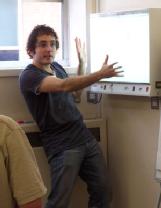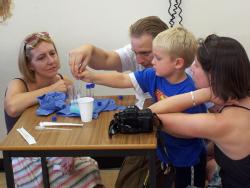Workshop: DNA
 Deoxyribonucleic Acid
Deoxyribonucleic Acid
Each of us is different, and all the information that makes us who we are (such as hair and eye colour) is contained in our DNA. DNA (deoxyribonucleic acid) is a molecule found in each of our body cells. It is in the shape of a spiral staircase, one half inherited from our mother, and one half from our father.
In 1953, Watson and Crick, two scientists working in England, were the first to figure out how DNA stores chemical information. This made it possible for scientists to begin ‘reading’ the human ‘book’ of DNA.
In 2003 scientists finally completed recording the full book of human DNA. Now all that remains is for them to understand exactly what each ‘word’ and each ‘sentence’ means.
Every day we are learning more and more about how DNA controls the millions of chemical reactions within our bodies. This knowledge is allowing doctors to prescribe medicines that are more perfectly suited for each of our bodies and unique genetic makeup.
DNA and Hospitals of the Future
Our bodies contain infection-fighting cells called T-cells. Apart from seeking out and killing foreign bacteria and viruses, T-cells also naturally eliminate small tumours. Unfortunately, our bodies do not contain enough T-cells to destroy large cancerous tumours. Cancer cells also often manage to cleverly camouflage themselves to avoid being detected by T-cells.
Through a new technique called T-cell Therapy, T-cells are extracted from a cancer patient and genetically modified to help them recognise and focus in on malignant cancerous tumours. The T-cells are then multiplied 1000-fold, and injected back into the patient. With this massively increased and specialised army of T-cells, the patient is far better equipped to eliminate even the most aggressive forms of cancer.
Early results of this technique have been described as ‘spectacular’, and some scientists even predict that a cure for all types of cancer could be available on the NHS within five years. Learning to read and understand the ‘book’ of human DNA is beginning to produce astonishing benefits for humanity.
Workshop: A Little Piece of YouParticipants in this workshop extracted a sample of their own DNA, a procedure common in hospitals today. First they collected cheek cells from the inside of their mouth. With the cells in a test tube, they broke them open by adding a soap solution, releasing the cell contents and the DNA. After adding an enzyme to remove the proteins associated with the DNA, thereby causing the DNA to untangle, participants added some salt solution to neutralise the DNA strands, allowing them to come together again in the test tube. To force the thin DNA strands to clump together and become visible, the water molecules packed around the DNA were removed by adding a cold, concentrated solution of alcohol. Once the DNA began to form large visible clumps, some of it was removed and added to a small bottle that was then suspended on a string. All participants took home a little piece of themselves in the form of a personalised DNA necklace.
